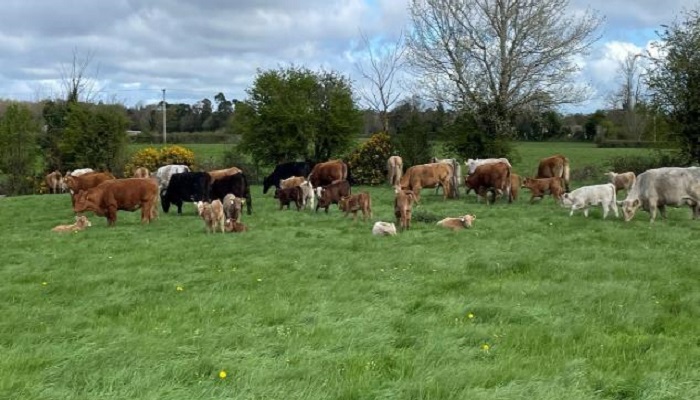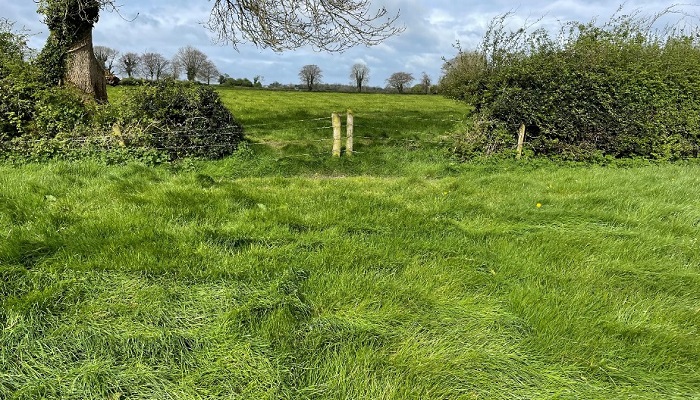15 May 2024
How this Future Beef Farmer plans to make quality silage

Teagasc Future Beef Programme participant, John Dunne has plans to replenish his silage stocks after a long winter. Along with ensuring sufficient fodder is available, he’s targeting the production of high-quality silage in the first cut.
John farms a total of 125ha between owned and leased land. He lives in Tinacrannagh, just on the outskirts of Portarlington. He farms full-time and is also helped by his son James in the evenings and on weekends.
It is a busy farm, with 90 suckler cows calving from the beginning of February. Like most spring-calving herds, getting calved cows out to grass this spring has been a challenge. In addition, there are a lot of priority stock, such as yearlings, that had to be housed longer than planned. John managed to get cattle out grazing in the middle of April, over a month later than normal.
Fortunately, John had plenty of fodder on farm after making surpluses in 2023. However, reserves have become depleted and John needs to concentrate of making sufficient silage for next winter, with a buffer of one month. John also wants to target making some high quality silage for the priority groups of 200 weanlings and 200 stores next winter. Is this still possible given that closing of silage has been delayed by almost a month this year?
During a visit with John on April 16 the following was decided:
- The silage ground at home in Tinncrannagh would get 60 units/ac of protected urea + sulphur. The ground is all index 4 for phosphorous (P) and potassium (K). Spreading 60 units would mean that the crop could still be cut in the third week of May. John will then apply slurry plus another 60 units/ac for a second cut. Closing in May is a better option that delaying into June.
- After walking the grassland area on the out farm in Rathefeston, there were paddocks that are gone too heavy for grazing. John decided to apply 2 bags of 18.6.12/ac and he will cut the paddocks when making the first cut in May. Rathfeston is at index 1 and 2 for P and K. This will add to the tonnes of silage harvested and also bring the paddocks back into the rotation with quality after grass.

A heavy grass cover on John’s farm in Rathefeston
Ragwort control
John also has plans to control Ragwort (Senecio Jacobea), also known as ragweed or buachalán, which is poisonous in the green and preserved state and has been responsible for many animal fatalities. Ragwort is listed as one of many noxious weeds in the Noxious Weeds Act. It is also a biennial plant (lives for two years).
Ragwort poisoning can show symptoms such as tenesmus, hind limb weakness and severe animal pain, according to the Department of Agriculture, Food and the Marine. John has a section of land that he wants to spray for the weed. Treating Ragwort needs some consideration with regards to timing of the application.
Normally, animals don’t eat Ragwort in pastures unless grazed grass availability is extremely restricted. An animal must consume up to 12% of the animal’s body weight in the weed to cause severe problems. Ragwort becomes more palatable to animals when cut or sprayed, as this releases sugars in the plant. Most fatalities occur where there is a mixture of ragwort finely chopped in hay or silage, where cattle are forced to eat this palatable ragwort.
Spray control
At smaller infestation levels, pulling of ragwort can be a successful control option. For larger infestation numbers, sprays such as MCPA, 2, 4-D (D50) and Forefront provide good control, but measures must be taken to avoid stock eating any dying or dead ragwort present.
The key points in chemical Ragwort control include:
- The best time to spray Ragwort is at the rosette stage, roughly around half the size of a rugby ball;
- The larger the ragwort the longer it takes for the carcase to rot down and not be cut in silage/grazed;
- Avoid spraying once the plant becomes stemmy;
- Ensure the plant is actively growing;
- Spray in the spring (February to mid-March) or late autumn (September to mid-November);
- Ensure that the plant is fully decayed into the soil before grazing again (usually 5 to 6 weeks).
- John has grazed the area bare and once the rosettes show, he will spray and keep the animals off the paddocks for six weeks.
Breeding
With AI used on over 70 cows and heifers on April 22, John wants to ensure that they are on good quality grass. Luckily, the weather has dried up and ground conditions have improved in the week post insemination. Cows are more settled. The Charolais bull has been let out with the cows, while the Angus has gone with the maiden heifers.
John is hoping for a 60% conception rate with the synchronisation programme and he will scan at the end of the month. May is all about observing to ensure that the bull is working and for watching repeats. The bulls were given a ‘NCT’ in April. There were issues in the past with an infertile bull, so observation is key during May and June.
This article first appeared in the Future Beef Newsletter for May. Click here for more information on the programme and to sign up to future newsletters.
More information on John Dunne’s farm is available here.
